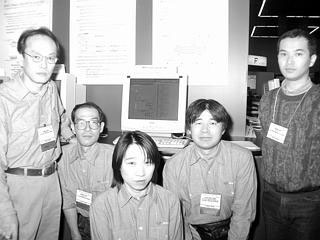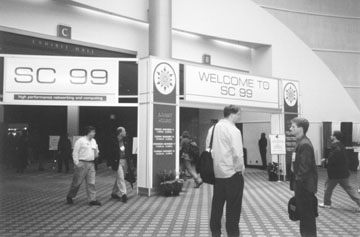
Entrance to SC99
The annual SC (High Performance Networking and Computing), the largest show in the field of high-performance computing, was held from November 13 to 19 at the Oregon Convention Center in Portland, Oregon, USA. This conference covers technical sessions from platforms to applications, and working group meetings, as well as showcases by vendors and research institutes, and product presentations by vendors. SC finally returned to Portland after SC93 was held there. It is often rainy in Portland at this time of year; the previous SC93 was famous for the umbrellas given out at booths, and SC99 was again no exception.
How far has the show changed from Supercomputing to High Performance Networking and Computing?
The importance of supercomputers as Super Internet platforms has begun to attract attention. But at SC99, this was not a clear trend. Some time ago when supercomputer vendors withdrew from this conference, I was under the impression for several years that the heyday had passed, but the mood has changed since last year.
First, PC vendors with no relation to supercomputers had booths. As the Intel chips improve in performance, PC clusters are now supercomputers. On the other hand, in business terms, as the Internet proliferates, dramatic increases in the amount of data to be processed are leading to the need for high-performance servers.
Another noticeable trend was the importance of suggesting supercomputer-based solutions by vendors which compete for market share.
There were no new presentations on hardware, but there were many showcases on application program development tools. Many people felt that this year was more successful than last year.

As for my expectation to the next year, the SGI preview, which was held at a nearby hotel the night before SC99 opened, was impressive. They showed a 4-cluster machine with Intel's 64-bit architecture Itanium processors known as IA64. I happened to know this preview from a flyer thrown into my hotel room, but it exuded enthusiasm, and by combining next-generation processors and fast-growing Linux, it is attracting much attention. The next SC2000 may clarify its impact on this industry. The RWCP presented its R&D results on networking (RHiNET-2), parallel execution environment (SCore cluster system), parallel programming environment (OpenMP, PROMISE, SPST), and parallel applications (PAPIA, MolTrec). We received many visitors and as the years have passed, it has become recognized as a national project, and the research results have become widely known. The RWCP booth was as large as a vendor booth, and we had no trouble during the entire period thanks to the efforts and guidance of Yutaka Ishikawa and others.
The Multiprocessor Computing domain had an OpenMP Corner together with the Parallel and Distributed System Performance TRC Laboratory.
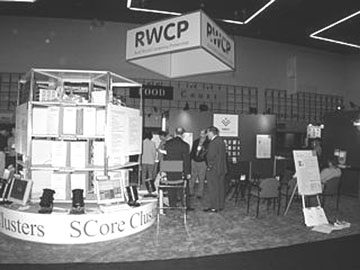
OpenMP is a standard parallel programming interface for shared-memory
multiprocessors, and features an incremental parallelization ability by adding
parallel instructions to sequential programs in Fortran and C. It is supported
on many recent parallel computers, and programs written in OpenMP can run on any
computer, so users enjoy the benefits of improved program portability.
The
Hitachi Laboratory showed WPP (Whole Program Parallelizer) which generates an
OpenMP program from a sequential program consisting of multiple procedures by
parsing it and automatically detecting parallelizable portions, and a tool for
visualizing the progress of parallelization. This enables effective parallel
programming and makes it easier to improve the performance of parallel
computers.
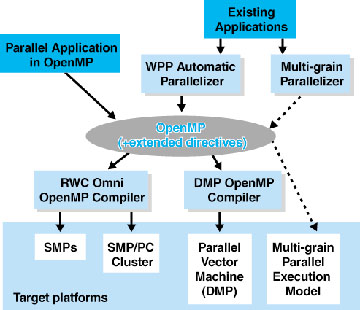
The Parallel and Distributed System Performance TRC Laboratory showed the
Omni OpenMP compiler which enables OpenMP programs to be run on many different
parallel computers. This compiler can support any computer that supports the
POSIX thread library. In a demonstration, an OpenMP program generated by WPP was
converted by the Omni OpenMP compiler into COMPaS, which is code for PC-based
SMP cluster machines, and was actually run.
The Fujitsu Distributed
Laboratory showed a prototype compiler which supports an interface for
distributed-memory multiprocessors, missing in the current OpenMP, as extended
specifications to OpenMP. The purpose is to extend the application of the
OpenMP-based interface to distributed-memory multiprocessors as well as
shared-memory parallel computers.
OpenMP is certain to be a core system in the future, so many people asked for explanations. Many were interested in more detailed documentation and requested trial use. Its functions and quality are not yet sufficient for practical use, so we need to continue our R&D efforts to improve the current results to a level that allows practical use.
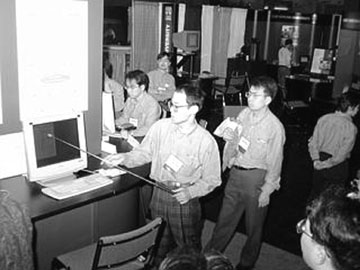
This year's SC ended in a flash. It had a wealth of content and I could not cover it all, but I'm looking forward to the next SC to experience something new. SC2000 will be held in Dallas, Texas.
Finally, the Multiprocessor Computing domain will end its reseach in the RWC Project this fiscal year. I'd like to say "Thank you" to everyone who helped us during the last 3 years and wish them success in the remaining 2 years of RWCP.
